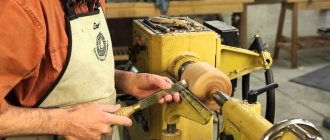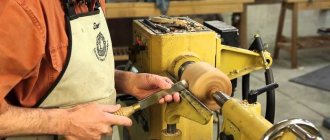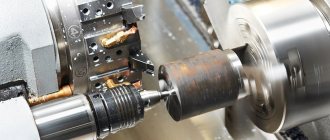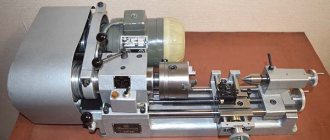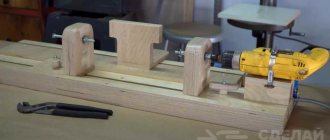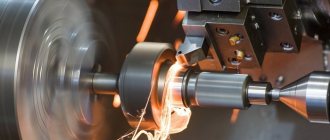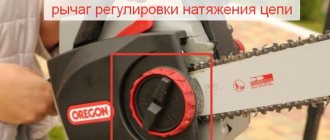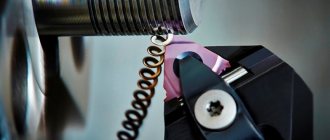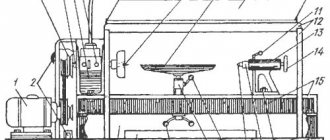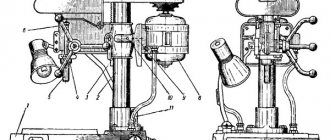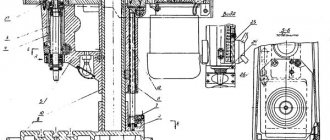Properties and characteristics
Using amateur equipment, you can make souvenirs, dishes, small items for the interior, furniture parts, sharpen tools and drills, select grooves, and apply carvings with your own hands. Parts of complex shapes, cone-shaped and cylindrical, are processed.
Using properly selected equipment, you can sharpen not only wood, but also some types of plastics and soft metals.
Features of compact models for home:
- low power - 350 - 500 W;
- small weight - from 17 to 40 kg;
- workpiece rotation speed within 400 - 3400 rpm.
On the most productive lathes of this class, you can make small batches of parts for sale with your own hands.
Design and principle of operation
All components and parts of the lathe are located on the frame or bed. The main design elements: a front support with a drive and a transmission shaft, a rear support for fixing the part and a mobile stand for the cutter. A drive chuck is located in the chuck, which transmits rotational motion to the workpiece. The tailstock holds the free end of the workpiece; it is especially necessary when working with long parts. A cutter stand or support supports the cutter in the right place.
The workpiece is fixed in a lathe between the centers of supports or on a faceplate. When working with wood blanks, the first method is most often used, which does not allow processing the ends. Mounting on a faceplate is used when processing end surfaces; it is more reliable. The part is secured using bolts rather than chuck teeth.
When fastening, it is important to center the part so that it does not “beat” during movement. For this purpose, an angular type center finder is provided.
The cutter is fed manually; it is fixed only when working with a copier. In other cases, the master holds the cutter with his own hands with emphasis on the thrust bearing.
The workpiece is turned in two passes:
- rough: at an angle of up to 30 degrees;
- final: at an angle of up to 45 degrees.
For each pass, material no more than 1 millimeter thick is removed.
When choosing a lathe for home use, you should pay attention to the amount of spindle runout. A very good result is 0.02 mm, because working with wood processing equipment with your own hands does not imply perfect accuracy.
General design and purpose
Woodworking lathes have one functional purpose: processing workpieces. The output products take the form of a detail in the outline of the future furniture design, room interior, or decorative design.
The scale of production and processing of wood products depends on the equipment used. Manufacturers produce 3 types of machines:
- school;
- household;
- industrial installations.
The design of the devices is no different. They have different capabilities for processing parts. With high speed, accuracy, availability of devices, closers, sizes of installation fasteners. Their unit electrical power consumption differs.
Review of the most popular models
Let's look at the characteristics of several models of lathes for amateur use.
| Kinzo 48P5600 | Proxxon DB250 | Jet JML-1014i | Caliber STD-350 | Corvette 71 | |
| Type | desktop | desktop | desktop | desktop | desktop |
| Power, W | 350 | 100 | 370 | 350 | 370 |
| Electric motor type | asynchronous | collector | collector | collector | asynchronous |
| Rotation speed, rpm | 850 — 2150 | 1000-5000 | 500 — 3900 | 500 — 3400 | 760 — 3200 |
| Maximum workpiece dimensions | 1000 x 350 | 250 x 80 | 350 x 250 | 330 x 250 | 420 x 250 |
| Spindle size | 1 x 8″ | M16x1 | 1 x 8″ | 1 x 8″ | 1 x 8″ |
| Weight, kg | 38 | 2 | 30 | 17,5 | 38 |
Table 1. Technical characteristics of lathes for home
Kinzo 48P5600: the bed is made of rectangular pipes, it is possible to use an extension for processing workpieces longer than 40 cm. You can change the speed of rotation of the workpiece by rearranging the belt on the pulleys (4 pairs). When purchasing such a machine, you should pay attention to the alignment of the front and rear axles. When pressed by the rear stand, the base may become deformed. Fragile plastic handles with clamping bolts.
Jet JML-1014i: solid cast iron frame. The rotation speed changes smoothly in several ranges. To change the range, you need to move the belt on the pulley. It works very quietly, it is convenient to set the speed on the electronic unit. To lock the spindle, a push handle is provided, which is located on the left.
Proxxon DB250: aluminum frame, very small in size, allows you to turn only the smallest parts for aircraft modeling. During operation, it is advisable to attach the device to a workbench, otherwise the light alloy structure will dangle. It works very quietly, there is no beating, but the power of the machine is low, so you need to work carefully and slowly.
Corvette 71: cast iron frame, rotation speed is changed by rearranging the belt pulleys. Despite its small size, the design is no different from professional turning equipment. The engine maintains stable speeds, practically does not vibrate and makes no noise. The tool rest is short, it is clearly not enough for internal turning of parts longer than 110 mm. Equipped with a convenient eccentric mechanism for rearranging the tool rest.
Caliber STD-350: neat frame made of cast iron. The center of the rear and front axles may not coincide, which is very difficult when working with short parts made of dense wood. The spindle does not hit, it is easy to adjust, the frame is durable, and it works quietly. Weak frequency regulator - torque at the minimum position is almost impossible to use.
Homemade lathe
With your own hands at home, you can assemble a turning device that is in no way inferior to a factory one.
Materials for the frame: wood, ferrous metal (welded), light alloys (bolted), textolite. The main thing is that the structure is stable and strong, and that the centers of the headstocks coincide.
Drive: the easiest way is to take a ready-made part from an old drill, but an asynchronous electric motor from any equipment with a power of at least 150 W will do.
Guides: depending on the material of the case, this can be a gap in the base, wooden slats, or a do-it-yourself aluminum rail.
Review of a homemade lathe for the home and demonstration of its operation in the first video and selection of a finished one in the second:
A specialized wood lathe allows you to make various products and their copies from wood, provided you have a copying device. A woodworking turning unit is lighter when compared to a metalworking unit, and also uses less powerful electric motors. If we are talking about industrial applications, then CNC models are relevant here, and the faceplate serves as a workpiece clamp.
All machines on the market are usually divided into three groups.
- Industrial. These are mainly CNC models, the weight of which is about 100-200 kg on average. The power of the electric motors used is 1 kW. Distinctive features are increased productivity, extensive functionality and the ability to put production on stream. The retainer is a faceplate or headstocks.
- Semi-professional or intended for small production. The weight of the units varies from 40 to 100 kg. Power ranges from 500 to 900 kW. The technical characteristics allow the use of a semi-professional woodworking machine for small production or a workshop.
- Household. They are tabletop. A similar woodworking machine weighs no more than 40 kg. The bulk of such units usually weighs 20-25 kg. They are distinguished by their compactness and mobility, but not by their productivity. They are used only for producing single products, although they can be equipped with a CNC module.
Depending on the functionality, turning units can be:
- Combined. Their specialization is performing a wide range of operations on one machine. At the same time, the price of such machines is high, and their processing quality does not always correspond to the expectations and financial resources invested;
- Specialized. Specialized machines make it possible to produce various crafts and wood-based products, working according to certain limited patterns.
It is important to note that specialized devices are divided into three subtypes:
- Turning and milling. With their help you can make, process and bore grooves.
- Lathe-screw. This type of woodworking specialized machine is used to work with cone-shaped products and apply threads.
- CNC. Multifunctional devices that perform a whole cycle of woodworking operations. An important feature of the CNC module is that it performs all the work automatically. Operator involvement is minimal. His task is to set the desired program from the CNC list.
At the same time, any woodworking unit is capable of:
- trim;
- grind;
- Drill;
- Make grooves;
- Cut thread;
- Make holes;
- Grind the ends;
- Grind;
- Make openings.
Specifications
Many craftsmen make a wood lathe with their own hands, while others prefer to purchase ready-made devices. When there are such models on the market as STD 120m, Corvette 74, STD 1000, Holzstar db1100, no chisels or planes are needed.
Experts advise focusing on the following parameters.
- Motor power. Electric motors determine the processing capabilities of the machine, but at the same time affect energy consumption. Industrial models use engines with a power of 1-2 kW. And for household needs they choose 300-500 W.
- Workpiece sizes. Here you should pay attention to the center-to-center distances to the machine bed.
- Spindle head rotation speed. This is the main working tool, capable of rotating at a frequency of 400 to 35,000 revolutions per minute. The quality of product processing directly depends on this parameter.
- Manufacturer and warranty. Many experts recommend choosing brands like Corvette, STD and Holzstar.
The choice of the presented versions of devices is not limited, but they are deservedly popular.
Design Features
Let's study the general design principle of such equipment.
- The basis is the bed, the quality of which determines the accuracy of woodworking and the stability of the turning equipment itself. All elements and mechanisms are located directly on the frame. The best option for making a frame is cast iron and solid casting.
- The workpieces are mounted in driving chucks, which are located on a rotating spindle. A faceplate or tailstock with a rear chuck allows you to fix the product on both sides at once.
- Depending on the length of the cutter, the thrust bearing moves. The cutter partially rests on it while processing workpieces.
- Workpieces can be fixed in two ways. For the first, the centers of two cartridges are used, and for the second, a faceplate is used. If you prefer to make your own homemade wood lathe, you will need a faceplate when turning the ends. The peculiarity is that the faceplate provides for fastening products with bolts, and not with points. A faceplate is preferable because it fixes the product more reliably.
- The most important design difference between turning units for processing metal and wood is that the woodworking version involves manual feeding of the cutter to the product.
Homemade wood lathe with V-belt drive
I've always wanted something like this. A lathe for metal is still something more utilitarian, and with wood... of course there are also options, but still, this is a device for making something decorative and artistic. When we settled in the Perm region, in a village, I assembled this unit for ourselves. I'm bragging.
Innocent looks at the lathe, admiring the rotation of the part. Sparkling shavings fly between the legs, and the squeal of steel is heard. "Innocent at the Factory" BG
I was lucky, a friend let me work in his heated garage (and it was winter) and promised to help with welding. In the garage there was a school lathe for iron and a drill. Portraits of the heroes are below.
Next door there was a construction base trading, including rolled metal. First of all, having studied the assortment of glands, I sat down to study analogues and preliminary design. We had to tinker, some parts and even assemblies underwent slight changes during the manufacturing process, but this happens in any production - assembly according to “polished” drawings is the lot of series.
What was used.
Tools.
A set of plumbing tools, tools for cutting threads, a power tool – a drill, a cutting machine – made things very easy. I used a small (school) metal lathe; several large parts had to be turned on the side - they did not fit into the chuck. Welding machine with accessories. A medium-power soldering iron with accessories and a set of tools for electrical installation; I often had to “wire” circuits—you can’t do without a probe or multimeter. Hand tools for wood. I used hot glue.
Materials.
Standard rolled metal, threaded rods, and hardware were used. An electric motor was purchased. Bearing supports with a shaft and some other pieces of iron from scrap metal. Some felt for the seals. Sheet textolite. Bearings. Plywood for electrical boxes. Electrical elements for starting the motor, wires, cables. Sealant. A little galvanized steel for fastening cables when laying along structural elements. Paints and paints, brushes, rags. Lamp for local illumination.
electric motor was found and purchased
. I was lucky - I got an old motor, but in factory lubricant, from storage. 1kW, 800 rpm. The venerable age of the engine is also good; in “those” times they saved much less on steel and copper, the dimensions of the engine fully confirm this. I strived for relative slowness. It is more pleasant to work without fear, and to obtain a clean surface not with high speeds, but with the correct turning technique. The engine speed can be changed by changing the V-belt drive belt.
Its three positions are provided - the spindle speed is equal to the engine speed, more and one and a half times less. Practice has shown that this is quite sufficient for ordinary work. A significant reduction in speed is only necessary when “duping” very large workpieces, the size of a good stump. But such deceleration is usually done by an additional pulley and belt. You may need to install them in the future.
Ramu
, I wanted to make it as massive as possible - I came across similar lightweight units, nothing comforting. The rental store was very close to the assembly site, so there was no hired transportation or rigging work. I simply brought two pieces of a powerful I-beam from which the base of the machine was made on a sled. The rest is even simpler.
Here is a photo of the machine frame and some smaller elements and blanks. A sort of “shell” with glands around it, this is a potential tailstock
. Made according to the simplest scheme from a standard “store” stud with metric thread. It is screwed into two corresponding nuts at the ends of the “projectile” and secured by locking it with another nut on the outside with a handwheel handle.
Paws up, mounted the belt tensioner
. It's that pin on the hinge sticking out in the oval hole. On top there is an electric motor on a turntable; a pin will pull this platform by the edge.
The hinge is slightly larger. The nut at the end of the stud is for easy drilling of the hole.
Headstock
. The most important and perhaps the most precise component of the machine. I had to make one from scrap metal - I found a slightly bent shaft in two bearing supports. Looks like it came from some kind of combine harvester. The unit was washed and cleaned, the shaft was at least aligned, everything was converted to tapered bearings, and since they require axial tension, a number of auxiliary parts and their adjustment were required. But I mastered it.
Oil seals
- anthers. Wood dust is much more unpleasant than metal dust, because, unlike the first, it is much lighter and is carried into the most remote corners of the mechanism. Particular attention must be paid to dust protection here, especially where bearings and lubrication are located. Option one. Quite functional, but was rejected for aesthetic reasons.
Option two, current. The seal itself is made of thick felt impregnated with lubricant, the surface of the shaft underneath is polished.
Pulley block
. A friend found a number of large gears, for some reason made of PCB on a metal sleeve. This is one of them, cut out, glued, sharpened.
Switching on a three-phase electric motor
into a single-phase network - the textbook, “capacitor start”.
The capacitance of capacitors C1, C2 is calculated using known formulas, depending on the motor data, I got 100 µF and 150 µF.
Electrical cabinet blank
. Made from plywood and wood.
Preparing the remote control
. From the same thing.
It’s a bit cramped, therefore, the installation needs to be thought out quite carefully, step by step, otherwise you might not get to something later.
O. Victoria! Everything worked out.
By the way, the toggle switch is for the light.
Electrical cabinet in the process of installation. The transformer is for a halogen light bulb for “local lighting”, capacitors for running a three-phase motor from a single-phase network, see diagram. There is also a three-phase network in the village, but the phases here are often “skewed” and break off, which can be overlooked, which threatens to overwind the electric motor. Need bulky protection. Again, there is already enough power with the current switch on.
Window for a machine gun. So that it can be turned on and off without removing the front wall of the cabinet. Well, just to see what position he is in.
I dulled the sharp edges with a grinder and a magic file, went over the rusty areas with a wire brush and then sandpaper, wiped it with gasoline, and painted it in two layers with green PF-115 enamel. After drying, I started installing and wiring the electrics.
By the way, this is why I had to make my own cabinet for electricity - so that it fits elegantly into the I-beam gutter.
Assembly of the mechanical part - assembly after painting and installation of the headstock, installation of the motor, its electrical connection.
But what I forgot was the lamp bracket! This is practically my first welding experience - an acquaintance helped me with basic welding work, then he got bored of messing around with me, so I had to master “this business” on my own. The halogen lamp is from a broken table lamp. 12V. The transformer is in the electrical cabinet nearby. In this case, you should not use energy-saving lamps - when a part rotates under such lighting, a stroboscopic effect may occur, the rotating parts look motionless, this can cause injuries, which is not desirable.
As they say in the technological process... “after modification, restore the paintwork”
Uh, second experience in welding... Making a tool rest. Two at once. From the same standard rental.
That's somewhere like this. Fitting. It should be said that the tool rest turned out to be not the most successful - the vertical cut tube is not secured very securely and the cutter vibrates at the edges of the tool rest when turning. But we can bear it. I won’t be able to strengthen everything a little - weld a couple of braces.
Thoughtful...if you paint it, it's not so bad.
Almost assembled, the final touches are adjusting the precise alignment of the tailstock stop and the front spindle, the planes of rotation of the pulleys, and other little things, in a word - fine tuning and optimization. In relation to the moment, the sledgehammer caught in the frame on the floor near the stairs looks charming.
As Yuri Alekseevich said - let's go! I’ve already sharpened a whole tub of wonderful shavings, not in vain, not in vain!
The first experiments were a stand for pyramid incense (by the way, also homemade).
Mmmm... White?
A few years later, when I made a grinding wheel on the machine shaft to sharpen the cutters, it became necessary to rotate the spindle in reverse
. I made a small modification to the electrical part of the machine, fortunately, for this switching on, getting the motor to rotate back is a couple of trifles.
In addition to safe sharpening, the possibility of reverse rotation of the workpiece improved the quality of grinding of finished parts, especially during transverse turning (plates, soles of candlesticks, etc.).
Become the author of the site, publish your own articles, descriptions of homemade products and pay for the text. Read more here.
Popular models
Working on a wood lathe is a fairly common activity in home workshops and factories. If you need a unit for personal purposes, drawings, photos and video instructions will allow you to make an excellent unit with your own hands.
Or pick up a chisel and get to work. Chisels are an old-fashioned alternative to woodworking machines. So chisels, planes and other hand tools will not achieve the same result as automated chisels, that is, machines. They will be with CNC or without a CNC module, it’s up to you to decide.
The list of popular models includes the following modern “chisels”:
- Corvette 74;
- STD 1000;
- STD 120m;
- Holzstar db1100.
Let's consider them separately.
- The Corvette 74 is a 550 watt floor standing unit. The diameter and processing width are 300 and 845 mm, respectively. The Corvette weighs 74-85 kg. The spindle speed range on the Corvette 74 machine is from 500 to 2000 rpm. The current cost is 30 thousand rubles.
- STD 1000. Drive the unit 22.9 kg. The maximum processing diameter of the model is 350 mm. The power of the unit is 400 W, and the rotation speed is from 810 to 2480 rpm. The price of STD 1000 is about 11 thousand rubles.
- STD 120m weighs 100 kg and operates on a 380 V network. The power is 0.4 kW. The processing diameter is up to 190 mm, and the rotation speed of the STD 120m spindle is from 1100 to 2150 revolutions per minute. Price - about 45 thousand rubles.
- The Holzstar db1100 is a German machine weighing 92 kg with 10 speeds and a maximum processing diameter of 358 mm. The unit is powered by a 220 V network. The estimated price is 55-60 thousand rubles.
Do you need a CNC model, a high-strength faceplate and a wide range of adjustments if you are going to do general small crafts? No. CNC and faceplate are the prerogative of modern, powerful devices with high functionality. If you want to make ordinary crafts, you can try to assemble the machine yourself.
If large-scale production is planned, working with large products, the faceplate as a clamp will become indispensable, and the CNC module will simplify the work.
Everyone who is interested in turning sooner or later has a question about purchasing. A modern wood turning machine is a universal unit for mechanical processing of wood. It is designed to be multifunctional. He has dozens of operations on his account. This includes turning, threading, drilling, creating holes and puzzles. It processes ends, shaped workpieces, conical and cylindrical surfaces. A lathe is equally indispensable for woodworking industries of various sizes, as well as for framing and carpentry workshops. Buying a lathe requires a reasonable approach, weighing all the pros and cons. After all, we are talking about very expensive equipment. How to choose a wood lathe so that the investment is worth it? You can look through hundreds of sites, but you will never be sure of the correct choice. The first step is to identify the area of tasks for the future machine. This will determine the selection options.
DESIGN AND DIFFERENT TYPES OF LATHES
The wood turning machine consists of:
- Beds (the basis for placing the necessary mechanisms and elements).
- Drive chuck (headstock). Responsible for rotating the workpiece.
- Rotating spindle. Adjusts the rotation speed.
- Tailstock. Provides fixation of the part.
- Movable thrust bearing. Sets the optimal distance to the workpiece
Examples of work performed on a wood lathe
Lathes come in tabletop and bed-mounted types. The frames can be cast iron, stable and durable. There are lightweight cast aluminum frames. Their advantage is the complete absence of corrosion. A desktop (portable) lathe is cheaper. It can also be installed on a special workbench or stand. To do this, the housing must have appropriate mounting holes. A wood lathe can weigh from 18 kg to 90 kg. The higher the weight, the less vibration will be felt. It's comfortable. But for home craftsmen, buying large lathes is not profitable. You can get by with a mini-machine. Machines also differ in phases. There are two options here - 220 V or 380 V. A single-phase machine is often purchased for the home. It all depends on the network you have. A three-phase lathe is generally more powerful. This is a productive stationary equipment, so it is not needed for rare private work around the house. The main criteria for choosing a lathe are the power and accuracy of processing parts. If turning is a hobby, then fundamental accuracy is not required. Of course, if the machine can perform fairly accurate work, then this is good. But the price of a functional and very accurate machine is higher. Often craftsmen working at home take care of silent work. A low-power machine makes less noise. If you choose a lathe from famous and reliable brands, then the very powerful motor is also noise-proof. For more detailed information, we have prepared the most important technical characteristics of lathes. They directly indicate their working potential.
Construction of a woodworking lathe
Structurally, various types of such units for processing wood products are built from elements that have the same functional purpose. Regardless of category, the lathe diagram includes the following elements:
- massive frame (the main components are located on it);
- headstock with fixed spindle;
- tailstock with elements for fixing the workpiece;
- a support used to feed the processing tool;
- rotation transmission drive;
- engine;
- rotation speed control system (performed discretely with several rotation speeds);
- electrical circuit elements;
- manual controls (usually they are implemented using various forms of handles, handwheels, electric buttons or switches);
- means of protection against dust and sawdust;
- individual machines are equipped with a special protection system in the event of an emergency;
- apron;
- the most advanced devices are equipped with a powerful vacuum cleaner for removing wood waste.
Despite the uniformity of the elements, each manufacturer offers its own wood lathe design, using its own technical solutions. The frame is made of cast iron or steel and is heavy, which helps stabilize the rotation of the engine and all rotating parts. All the main components are attached to it.
Any headstock of a lathe, including those for woodworking, is made according to a standard design. She has:
- spindle equipped with a workpiece fastening system;
- several bearings (three bearings are included: thrust, front and rear);
- special adjusting nuts;
- clutch for switching.
The second element is the tailstock of the lathe. It has two degrees of freedom. This feature allows you to change the position of the workpiece in the horizontal and vertical directions. This fastening system ensures high-quality processing of parts of the most complex shapes. To increase the rigidity of workpiece fastening in lathes, a quill is used. It is made in the form of a sleeve and moves along the main axis.
The support of a lathe has two functions:
- fixing the tool included in the kit;
- movement in specified planes for processing.
The support is located on the frame. It is equipped with two types of slides (transverse upper and longitudinal, which are called a carriage). To make a turn, it has a rotating system. The entire system of changing the position of the caliper is called the feed drive. The connection between the caliper and the spindle is through a reversible device called a snaffle.
The rotation of the lathe parts is carried out using a belt drive, which serves as a transmission element from the electric motor to the headstock. These elements make up the main movement drive. For each design, the manufacturer offers its own number of spindle rotation speed switches. In the bulk of machines, the range of rotation speeds of parts varies from 200 rpm to 1000 rpm.
The elements of the electrical circuit are located in a separate block. Thanks to this, control signals are distributed to all devices of the machine. A block consisting of electrical elements under voltage belongs to the first protection class.
Some caliper elements are manually controlled. The sleds are made universal. With their help you can attach another cutter.
The machine apron converts rotational motion into translational motion. In addition, it ensures synchronous rotation of the support shaft and the lead screw. The provided mechanical protection system prevents the simultaneous activation of these shafts. Smooth feed switching is ensured using a uterine nut.
To protect against possible overloads, a movable falling worm mechanism is provided in the machine apron. Such overloads arise as a result of increased external pressure on the surface of the workpiece, especially when using hand tools. This effect is observed when the rotation speed of the workpiece sharply decreases and the movement of the cutting tool slows down. This is especially true for machines on which manual processing of the workpiece is performed.
The specified speed of rotation of the workpiece greatly influences the quality of wood processing. For this purpose, the machine is equipped with a gearbox. It allows you to select the amount of torque depending on the type of wood and the operation being performed.
POWER IS THE MAIN INDICATOR OF PERFORMANCE AND ENDURANCE
When choosing power, the main thing is to decide what you need the machine for. If for a hobby or “folk art” products, then buy an inexpensive household-grade lathe. These are mini machines. They are ideal for small-scale production. They begin counting their power indicators at 350 W and end at 500 W. For medium-volume work, you should choose a wood lathe with a power of 500W-1000W. The power of a lathe is over 1000 W - this is already relevant for the large-scale industrial sector. Important recommendation: for professional work with heavy loads, choose more powerful machines. Then, when turning or drilling is set to maximum, you will not hear the engine slipping or a drop in speed. But if the motor is weak and does not pull the load, then this has a bad effect not only on the quality of work, but also on the service life of the engine.
DIMENSIONS OF PROCESSED WORKPIECES
The length and diameter of the workpiece are important when choosing. For entry-level work, you can buy a household lathe. It works with small workpieces or medium-sized blanks. The length of such blanks is up to half a meter, the diameter is a quarter of a meter maximum. It’s clear that you won’t get much speed on a household machine. If you need to process “hundreds” of wood every day, then, of course, choose a wood lathe of a higher class. From professional equipment. Such machines have extensions so that long parts can be sharpened. It is possible to turn parts about 1 meter long.
Types of lathes
Modern manufacturers offer a large number of types of woodworking equipment. Their classification determines the scope and technical capabilities of each sample. All types of lathes are divided according to the following indicators:
- application area;
- performance;
- number of operations performed;
- permissible part sizes.
The scope of application is divided into categories:
- industrial machines or machining centers;
- semi-professional equipment;
- household lathes.
Each of them includes several models of such devices. Each of them serves to solve specific practical problems. All lathes are divided into professional, semi-professional and household. Each of them serves to solve a certain class of problems in the manufacture of wooden parts. Any stationary machine requires large areas for installation and access to powerful high-voltage networks. A special class are compact units that can be placed on a desktop or workbench. The tabletop machine is very convenient for processing small parts in small quantities or producing an exclusive part.
Each of the machines of a specific type has its own performance. This depends on the permissible processing speed and the availability of modern mechanization means or the complete replacement of manual control with automatic control. Such units are equipped with numerical program control. They have the highest productivity and a large number of operations performed. Such machines are mainly included in the group of industrial equipment. They are heavy (some of them weigh more than 200 kg). The power of the engines located on such units reaches 1 kW. The number of operations performed depends on the design features that determine the possibilities for attaching the required cutting tool. To perform the planned number of operations, CNC machines are used
Semi-professional lathes are used for processing small batches of wooden blanks. They are much lighter than professional units. Its weight does not exceed 90 kg. The power of the installed motor is 0.5 kW.
The table-top machine is of greatest interest to home craftsmen. Its use is limited by placement capabilities, availability of a power source and the dimensions of future crafts. They are light in weight, not exceeding forty kilograms. They are equipped with low power motors, less than 0.5 kW. Each of these machines is capable of carrying out a wide range of processing procedures. They are divided according to the types of such operations: only milling, copy-milling, thickness planing, screw, pure turning, combined (to perform several types of operations, the machines are equipped with automation devices programmed for the sequence of required operations.
SPINDLE AND ITS FEATURES
The rotation speed and thread pitch of the spindle determine the performance. That is, the speed and quality of processing. These two values are responsible for the timely and full-scale processing process. The higher the requirements for the volume and speed of work, the higher the spindle speed must be. It is clear that the motor power must match. The lower the power, the lower the spindle speed. The quality of processing itself depends on the spindle speed. The lathe spindle can make from 400 to 3500 revolutions per minute. High-quality machines always have a speed controller.
Which wood lathe to buy: selection criteria
There are several main criteria that it is recommended to pay attention to when choosing a unit for processing wooden products. The main one is the power indicator, which determines the purpose of the device. For example, desktop models with low power are suitable for processing wooden products at home. If you need a machine for frequent use, then it is best to pay attention to devices with a power of 500 to 1000 watts.
Another important criterion that you should focus on when choosing turning equipment is the size of future wood blanks. A lathe is selected according to strictly defined characteristics. In this case, two indicators are important: the center-to-center distance and the distance from the base (bed) to the installed workpiece.
And finally, the third parameter that determines the accuracy of processing wooden blanks is the spindle speed. Today you can find machines with a speed range from 400 to 3500 rpm. In this case, the following pattern can be traced: the faster the spindle rotates, the more accurately the processing of the wooden blank occurs.
In any case, the choice of this equipment depends entirely on you. A wide range allows you to easily select the necessary lathe. A video on this topic will also help you decide on the choice of unit for home use.
Wood lathes are similar to metalworking units, but still have some differences
SPEED ADJUSTMENT
When working on a lathe, there is a need to change the rotation speed of the workpiece. Different operations require different speeds. Speeds are selected depending on the type of wood being processed and the required processing accuracy. Therefore, lathes are equipped with speed control. There are two types of adjustment - smooth and stepwise. The step adjustment is fixed at each value. The machine can have three to five speeds to choose from. To change them, groups of pulleys are installed. They move the transmission belt to the desired point. Smooth adjustment is considered much better. There is no need to stop the machine to change the speed. The process of switching speeds occurs smoothly, without jerks or fixations. The built-in variator is responsible for smooth adjustment. Speed adjustment is directly related to rotation speed.
Safety precautions at work
Working on a lathe, regardless of experience, requires compliance with established safety rules. It doesn’t matter whether a beginner turner or a sophisticated professional is working. All safety regulations can be divided into the following categories:
- requirements for the workpiece;
- correct fixation of the blank and the procedure for turning on the machine;
- tool preparation;
- preparation of personal protective equipment.
The first category of requirements includes:
- check the integrity of the workpiece;
- no obvious defects;
- humidity level;
- compliance with the requirements for the shape of the blank (this will eliminate runout of the part).
The second list is related to work rules. Before turning on the turning unit, you must read the instructions. It describes the sequence of preliminary work, the order of switching on, operating rules and possible malfunctions. In addition, the instructions, depending on the installed fixing device, contain recommendations for the correct installation and fastening of the blank. The main requirements for turning work are:
- securely fix the blank;
- check the integrity of the power cable (it supplies high voltage to the engine);
- serviceability of the grounding cable;
- all controls must be set to their original positions;
- there should be no debris or unnecessary objects on the bed and surface of the machine;
- During turning operations, chips should be removed gradually in a thin layer (it is necessary to avoid deep penetration of the tool into the workpiece, otherwise it may be destroyed, which will lead to fragments getting on your hands and eyes);
- It is advisable to press the elbow tightly to the body (this will create additional support, allowing for improved fixation of the instrument).
All tools that are planned to be used during work must be in good condition. Handles should not have cracks or obvious defects. The cutting edge must be sharpened according to the rules.
Before starting work, you should take care of personal protective equipment. These include: a protective gown, a hat and safety glasses. Having personal protective equipment will help avoid injuries.
INSTALLED COPYER
There are lathes with a copier installed, and there are lathes without a copier installed. A copier is an additional option in the machine. It is a removable auxiliary device that turns a regular wood lathe into a copying machine. Simplifies the processing of a large number of products of the same type. The copier guides the cutter along a strictly specified path, which prevents differences in the sizes and shapes of products. To increase the accuracy of your work, you should choose a lathe with a copier.
Types of turning equipment
Despite the variety of joinery products, all turning operations can be implemented using the following types of units:
- milling;
- turning;
- thicknesser;
- sawing
Milling is used for cutting out profiles and relief elements. To obtain the required shape and specified relief size, a milling cutter of a specific size is used.
A wood lathe allows you to carry out the entire range of turning, cutting recesses, grinding and polishing operations.
A thickness planer is capable of planing workpieces to a given thickness. In addition, depending on the number of knives on the shaft and the degree of their sharpening, it is possible to obtain a surface with a high degree of accuracy.
A sawing machine is necessary for carrying out work related to the preliminary preparation of flat wooden blanks. Sawing can be done along the installed beam or across it while maintaining the texture of the wood.
All woodworking (including turning) units are divided into three categories:
- industrial (used at large woodworking enterprises, furniture factories);
- semi-professional (used in organizations performing work in small quantities);
- household or desktop (used for individual work in home workshops).
The main differences are performance and weight and size characteristics.
REVERSE SWITCH
Reverse - reverse gear. This is also an additional feature. Not all machines are equipped with reverse. The essence of reverse in a machine is that it provides rear feed of the carriage and spindle. This speeds up the work. You do not need to re-feed the workpiece if the need for re-turning arises. You can simply turn on the reverse function. Which wood lathe is better - there is no definite answer. It all depends on your goals, capabilities, professional knowledge and financial resources. Advice and feedback from users are also important. Your experience and the above main points will tell you how to choose a wood lathe in full accordance with your expectations.
Using such a machine, you can turn balusters for the porch and stairs to the attic, make turned parts for platbands, intricate elements of external and internal decoration of the house, furniture parts and much more.
The basis of a wood lathe is a single-phase electric motor with a power of about 1 kW or a three-phase electric motor with a power of about 1.5 kW, connected via a capacitor circuit. It is better to choose an electric motor with a reduced number of revolutions per minute, no more than 1500 (preferably about 600-800).
It is necessary to talk in more detail about capacitor circuits for connecting three-phase motors to a single-phase network.
There is a large selection of three-phase electric motors, but not all of them are suitable for inclusion in a single-phase network using a capacitor circuit. For example, engines of the AO, A02, D, AOL, APN, UAD and some others series are good for these purposes. There are electric motors with a rated voltage of 127/220 V (the rated voltage of the electric motor is indicated on the passport label on its body). Such electric motors are connected to a 220 V network through capacitors only in a star circuit (λ). Electric motors with a rated voltage of 220/380 V - according to the “triangle” (Δ) circuit.
To obtain the maximum possible power on the shaft, electric motors are connected to a single-phase 220 V network according to the diagram shown in Fig. 117, a. Switch SA2 allows you to reverse the motor rotor.
The capacity of the working capacitor for an electric motor with a rated voltage of 127/220 V is determined by the formula:
Starting capacitors (C) in both circuits are chosen with a capacity 1.5-2.0 times greater than the working capacitors. Capacitors for the listed circuits must be paper insulated (brands MBGO, MBGP, etc.) and designed for an operating voltage of at least 350 V: If an electric motor with a rated voltage of 127/220 V, made according to the “star” circuit, has output ends to the terminal block (where windings can be switched), then use the circuit (Fig. 117, b) that gives the highest achievable power on the shaft.
The electric motor is started as follows. Press the “Start” button and turn on the “Network” switch. As soon as the electric motor picks up speed, release the “Start” button. If, with the selected working capacitor, the engine gets very hot during operation, select the best option by reducing or increasing the capacity of the working capacitor.
A faceplate is installed on the axis of the machine engine (Fig. 118, a). It has a central cone and four adjustable cones. The workpiece is placed on them and securely fixed. For small parts, use a smaller faceplate.
The second end of the workpiece is fixed in the center (Fig. 118, b). It is a corner holder welded from steel 4-5 mm thick. A cage is welded to the holder, into which a ball bearing is inserted with interference. A turned steel bushing with a thread for the center is pressed into the central hole of the ball bearing. The center is a pointed steel rod with a thickness of at least 16 mm with a continuous thread along the entire length and two flats at the end (for wrapping the center). Using three nuts, the center is secured to the sleeve. The limit washer fits tightly onto the pointed end. When installing the machine on a workbench, it is necessary to ensure that the central cone of the faceplate and the center cone are on the same line, that is, they are coaxial. Whenever the center moves, this alignment must be strictly observed.
Handles are installed on the workbench while the machine is operating (Fig. 118, c). They are usually made in three sizes: long, medium and small. The latter is made so that it can be attached to the workbench at different angles. The cutter rests on the tool rest when working.
Cutters can be made from flat files (Fig. 118, d). The roughing (roughing) cutter has a semicircular shape. The sharpening angle for hard wood is about 25°, for soft wood - about 35°. Finishing cutters are oblique in plan (with an angle of 70-80°), their sharpening angle is 20-30°. Sometimes finishing cutters are made with one-sided sharpening. The total length of the cutter (with handle) is about 500 mm.
The machine must be equipped with two wooden beams with a cross section of 80X80 mm, the so-called bumpers (Fig. 118, c). They are designed to throw the workpiece to the side if it falls off the machine.
Before starting work on the machine, select a workpiece (preferably without knots, dry). Aspen is usually used for external parts; it withstands external influences well. For internal parts, it is better to take linden - it is easy to process. Beech or oak are suitable for critical power parts. Conifers do not work well on a lathe.
Consider, for example, the manufacture of balusters. First, a rectangular beam is planed. A circle is drawn at the ends and the cylindrical workpiece is roughly planed with an ax.
The workpiece is placed against the faceplate of the machine so that the cone fits exactly into the center of the marked circle. Lightly hit the other end of the workpiece with a hammer to mark the indentations from all five cones of the faceplate. Using this marking, five holes are drilled with a drill with a diameter half as large as the diameter of each cone at the base. The depth of the holes is three drill diameters. At the other end, a hole for the center is also drilled according to the markings.
Insert the workpiece into the machine. To do this, use a hammer to push it onto the cone of the faceplate until it stops and bring the center under the hole. Place the lock washer and turn the center so that the lock washer is slightly pressed into the end of the workpiece. Screw the left nut all the way into the bushing (Fig. 118, b). On the other side of the holder, also screw the first nut all the way into the bushing and use the second nut to lock it.
Install a long tool rest and bump stops. Turn on the engine. Using a roughing cutter, they begin to remove chips no thicker than 1-2 mm (depending on the hardness of the wood). The cutter is held firmly with both hands and ensured that it always rests on the tool rest (Fig. 118, c). In order for the cutter blade to grind evenly, it is brought to the workpiece at different angles.
The workpiece is processed roughly until its diameter becomes 1.5-2.0 mm larger than planned. Then the work is carried out with a finishing cutter. The cutter is brought to the workpiece as shown in Fig. 118, d, and its blade is inclined relative to the generatrix of the cylinder.
Having received the desired diameter, proceed to marking the baluster along the length using the prepared template. It is driven with the sharp end of a finishing cutter (Fig. 118, e). All narrow passages are machined in the same way (Fig. 118, g). The rest of the processing (roundings, conical parts, etc.) is performed with a finishing cutter, as usual (Fig. 118, e). Control is carried out using templates, applying them to the part and ensuring that the outlines of the part exactly coincide with the contours of the template.
The finished part, without removing it from the machine, is sanded with abrasive sandpaper (the sandpaper is folded into a narrow strip and, holding by the edges, is brought to the part). Finally, the part is polished with wood shavings: holding a handful of shavings in your hand, press it against the surface of the rotating part.
